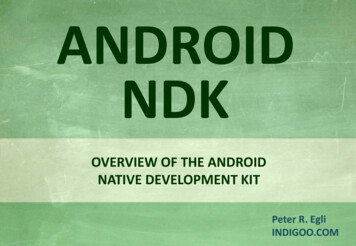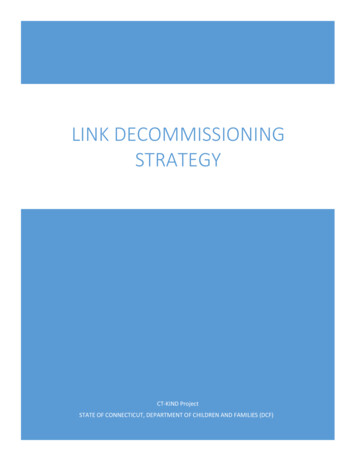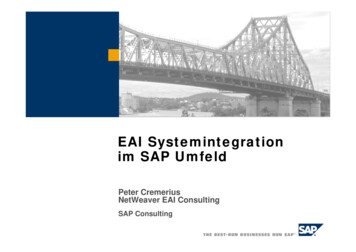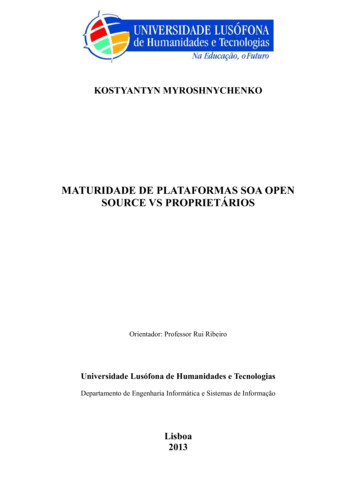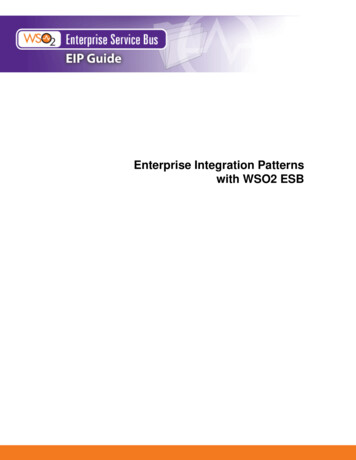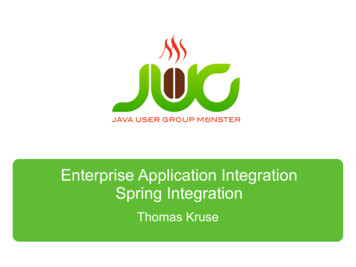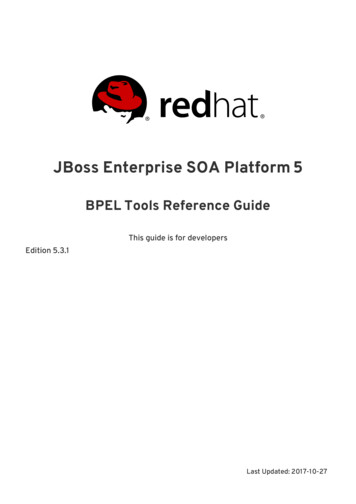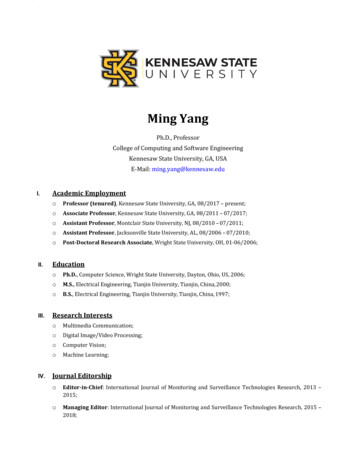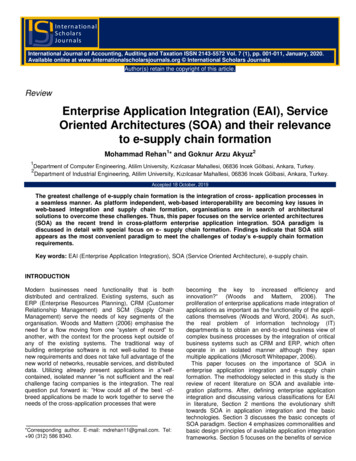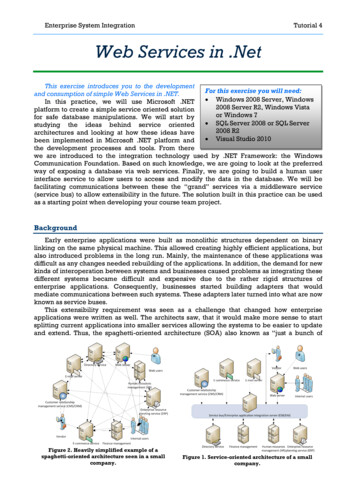
Transcription
Enterprise Application Integrationindigoo.comEAIOVERVIEW OF ENTERPRISE APPLICATIONINTEGRATION CONCEPTS AND ARCHITECTURES Peter R. Egli 2015Peter R. EgliINDIGOO.COM1/16Rev. 1.70
Enterprise Application Integrationindigoo.comContents1.2.3.4.5.6.7.EAI versus SOA versus ESBEAISOAESBN-tier enterprise architectureWS-BPELWOA Peter R. Egli 20152/16Rev. 1.70
indigoo.comEnterprise Application Integration1. EAI versus SOA versus ESB (1/3)What is EAI (Enterprise Application Integration)?EAI aims at integrating different enterprise applications. Thus EAI is a goal for enterprisearchitectures.What is SOA:SOA is an architectural pattern that aims at concentrating common (business) functionality intodistinct services and exposing these on endpoints. Thus SOA is a means or architecturalpattern to achieve EAI.What is ESB?ESB is an infrastructure component to facilitate SOA (ESB messaging backbone) and EAI.Architecturalpattern forSOAEAIInfrastructurecomponent forESB Peter R. Egli 20153/16Rev. 1.70
indigoo.comEnterprise Application Integration1. EAI versus SOA versus ESB (2/3)Traditional EAI architectures before SOA:Client ANo directaccess betweenclient andserver allowedClient BClient CClient DClient ESecurityESB (mediation MRMISCMHTTPPDMxyzOtherNo direct access betweenServers allowedIntegration of applications (common middleware infrastructure through ESB).Inefficient for compound services (services calling other services have to pass through thecentral EAI middleware (ESB) with security checks and transformations for each call).Limited reuse of services due to hidden endpoints (classical C/S architecture).ERP: Enterprise Resource PlanningCRM: Customer Relationship ManagementSCM: Supply Chain ManagementPDM: Product Data Management Peter R. Egli 2015CORBA: Common Object Request Broker ArchitectureDCOM: Distributed COMRMI:Remote Method Invocation4/16Rev. 1.70
indigoo.comEnterprise Application Integration1. EAI versus SOA versus ESB (3/3)The solution for EAI with SOA: Common functionality is exposed as services. Endpoints (services) are exposed to be freely called by anyone. Services may call other services, clients may call services ("liberation" of endpoints). Services form a service grid with exposed application service endpoints and centralizedinfrastructure service endpoints.TransactionESBSecurityLoggingS0 Peter R. Egli 2015S1S2S35/16Rev. 1.70
indigoo.comEnterprise Application Integration2. EAI (1/3)What is EAI?EAI is a business need or goal to integrate and couple diverse applications in an enterprise /organization. The benefits of EAI are: Share information between applications (basically connect the different DBs) and keep dataconsistent. Potentially reduce the technology landscape, reduce heterogeneity (standard interfaces ofservices mandate the use of standards, applications have less freedom to choose fromdifferent DBs, OSs, middlewares etc.). Faster and easier deployment of a new / updated application (interfaces for the integrationare defined, middleware technologies are in place).Traditional IT landscape:n*(n-1)/2 application interface connections.EAI architecture:Central communication backbone.with standard interfaces.Messaging backbone Peter R. Egli 20156/16Rev. 1.70
indigoo.comEnterprise Application Integration2. EAI (2/3)Typical EAI topologies:1. Hub and spoke: EAI system is at the center (hub),interaction with applicationsvia adaptors ( spokes).2. Bus: EAI system is a bus. Distributed message-oriented p.Hub(msg.Broker)App.AdaptorMessaging or Peter R. Egli 20157/16Rev. 1.70
Enterprise Application Integrationindigoo.com2. EAI (3/3)EAI building blocks:EAI can be accomplished in different ways. Most did not prove scalable (e.g. integration at DBlevel). Use of a centralized broker emerged as the best solution to the integration problem(scalability). This best practice has the following building blocks:1. Centralized broker: Handles security, access and communication. ESB2. Data model: Common data model based on a standard data structure. XML has become the de-factostandard.3. Adaptor / connector: Adaptors / connectors connect applications to the central broker.4. System model: Defines the interface including API and data flow to a component that connects to the centralbroker. Allows other applications to interact with this component in a standardized way. Peter R. Egli 20158/16Rev. 1.70
indigoo.comEnterprise Application Integration3. SOA (1/3)SOA aims to extract common (service) functionality from different applications and expose iton a service endpoint.In the basic SOA pattern, service consumer, provider and registry are separated into differententities.The service registry helps decoupling service consumer and provider so that the consumerdoes not need to know the location of the provider.The service registry is an optional entity. In smaller deployments running a service registry maybe 'overkill'.Serviceregistry1. Register(publish)2. FindServiceconsumer Peter R. Egli 20153. BindServiceprovider9/16Rev. 1.70
Enterprise Application Integrationindigoo.com3. SOA (2/3)Services can be exposed at different levels / granularity:Finding the right granularity is crucial for a successful SOA.A layering as follows may help in defining / decomposing the service icesBusiness servicesComponent servicesApplications invoke workflow services.Conversational workflow services have a state.Example: Expense processing service.Standard: WS-BPELOrchestrates component services into a single businesslevel process.Example: Submit an expense report.Simple atomic action on a resource; action doesnot depend on any other service / component.Example: Simple access to a DB table.Enterprise resources Peter R. Egli 201510/16Rev. 1.70
indigoo.comEnterprise Application Integration3. SOA (3/3)Standards are crucial for SOAs.These standards may be layered as follows:SemanticstandardsebXML, XML/EDIFACT, HL7 CDA, SWIFT etc.Service orchestration (WS-BPEL)Service discovery (UDDI, JAXR)InfrastructurestandardsService invocation, messaging (SOAP, WS-I / WS-*)SecurityTransactionsManagementService description (WSDL, WADL)XML (infoset, namespace, schema)Network protocol (HTTP, SMTP)ebXML:XML/EDIFACT:HL7 CDA:WS-BPEL:SWIFT:Electronic business XMLXML for Electronic Data Interchange for Administration, Commerce and TransportHealth Level 7 XML formatWS Business Process Engineering LanguageSocietiy for Worldwide Interbank Financial Telecommunication Peter R. Egli 2015Supportingstandards11/16Rev. 1.70
Enterprise Application Integrationindigoo.com4. ESBEnterprise Service Bus is an infrastructure to facilitate SOA.ESB is basically a messaging backbone / broker which provides the following functions:CategoryFunctionsInvocationSupport for synchronous and asynchronous transport protocols, service mapping (locating andbinding).RoutingAddressability, static/deterministic routing, content-based routing, rules-based routing, policybased routing.MediationAdapters, protocol transformation, service mapping.MessagingMessage-processing, message transformation and message enhancement.Process choreographyImplementation of complex business processes.Service orchestrationCoordination of multiple implementation services exposed as a single, aggregate service.Complex eventprocessingEvent-interpretation, correlation, pattern-matching.Other quality of serviceSecurity (encryption and signing), reliable delivery, transaction management.ManagementMonitoring, audit, logging, metering, admin console, BAM.Source: http://en.wikipedia.org/wiki/Enterprise service busExamples:MuleIBM WebSphere ESBMicrosoft BizTalk server Peter R. Egli 201512/16Rev. 1.70
indigoo.comEnterprise Application Integration5. N-tier enterprise architecture"Best practice" for "horizontal" decomposition of an application: 3-tier. Separation of concerns (user interface, business logic and data handling) improvesmaintainability and extensibility.Presentation tier:User interfacesWeb browsersHTML, JavascriptGUI clientsC , C#, Java Peter R. Egli 2015Middle tier:Business logicWebServerData tier:Data sources / sinksDatabasesMiddlewareServerLegacy Systems13/16Rev. 1.70
Enterprise Application Integrationindigoo.com6. WS-BPEL (1/2)What is WS-BPEL (Web Services Business Process Execution Language)?WS-BPEL is a language to define business processes based on web services.BPEL binds (web) services together to form larger complex business services.Thus BPEL is kind of a business programming language.BPEL provides:a. Control flow (branch, loop, parallel).b. Asynchronous correlation.c. Transaction support.For writing business programs, the following components are necessary:1. Programming logic (provided by BPEL).2. Data types (provided by the XSD of a web service).3. Input / output (provided by WSDL that defines the web service messages).WS-BPEL versus BPEL4WS:BPEL4WS: Original standards by BEA, IBM, MS, SAP and Siebel.WS-BPEL: Successor to BPEL4WS defined by OASIS (name to comply with WS-* scheme).WS-BPEL and BPMN (Business Process Modelling Notation):BPMN defines the (graphical) notation for business process elements while WS-BPEL definesan XML-based business process description language. Peter R. Egli 201514/16Rev. 1.70
Enterprise Application Integrationindigoo.com6. WS-BPEL (2/2)BPEL hello world example: ?xml version "1.0" encoding "UTF-8"? processxmlns ocess/"xmlns:print ine/Print" !--Hello World - my first ever BPEL program -- import importType "http://schemas.xmlsoap.org/wsdl/"location "././test bucket/service libraries/tptp EnginePrinterPort.wsdl"namespace ine/Print" / partnerLinks partnerLink name "printService" partnerLinkType "print:printLink" partnerRole "printService"/ /partnerLinks variables variable name "hello world" messageType "print:PrintMessage" / /variables assign copy from literal Hello World /literal /from to .value /to /copy /assign invoke partnerLink "printService" operation "print" inputVariable "hello world" / /process Source: ign/choreography html/tutorials/wsbpel tut.html Peter R. Egli 201515/16Rev. 1.70
indigoo.comEnterprise Application Integration7. WOAWeb Oriented Architecture is a concept that extends or simplifies SOA through the use of RESTand POX (Plain Old XML).WOA / REST is simply another (simpler?!) approach to SOA.Features / mplexitySource: -reach-web-oriented-architecture/27POX: Plain Old XML (like POJO, but with XML)JSON: Javascript Object Notation (more compact alternative to XML)BPEL: Business Process Execution Language Peter R. Egli 201516/16Rev. 1.70
Enterprise Service Bus is an infrastructure to facilitate SOA. ESB is basically a messaging backbone / broker which provides the following functions: Management Examples: Mule IBM WebSphere ESB Microsoft BizTalk server Category Functions Invocation Support for synchronous and asynchronous transport protocols, service mapping (locating and
